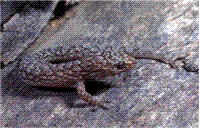Family
Gekkonidae (geckos)
Genus
Christinus
Species
marmoratus
Threats/Control Methods - Regional
Like many other lizards, urban expansion into previous habitat areas is of concern to the regional populations of this lizard. However, the lizard's ability to live in suburban areas with suitable rocky habitat means that the Marbled Gecko has a chance of adaptation.
Threats/Control Methods - Local
Feral and domestic animals can take Marbled Geckos in the urban area.
Local/Urban Actions
Marbled Geckos will inhabit rocky gardens that adjoin bushland or rocky areas. Creating rockeries or leaving rocky areas undisturbed may encourage the species, or other lizards, to take up residence in urban gardens which are close to nature reserves.
Common name/s
Marbled Gecko
Distinguishing Features
The Marbled Gecko is pale grey or brown above with a mix of dark patterned markings, creating an effect resembling marble. They are white or pale underneath. The gecko can grow to a little over 10cm including tail.
Similar Species
The Variegated Dtella (Gehyra variegata) has a similar general appearance, but has a more depressed body. The Marbled Gecko will tend to be found in cooler and wetter areas than the Variegated Dtella.
Distribution
The Marbled Gecko has a range which extends from central NSW, through western Victoria and South Australia, to the south-east of WA. Not present in the north of Australia or Tasmania. Marbled Geckos occupy the wooded and rocky areas of the ACT, including the gardens of suburban Canberra.
Country of Origin
Australia
Survey Techniques
Pitfall trapping and hand searching are employed in the surveying of this species.
Conservation (Pet/Pest) Status - National
Not listed as threatened at the national level under the EPBC Act 1999.
Conservation (Pet/Pest) Status - Regional
The Marbled Gecko is not a threatened species in the ACT, and may be kept by highly experienced herpetologists (see Reptile Policy).
LSCCES Population
The Marbled Gecko population of urban Canberra is thought to be stable, although no quantitative analysis has been conducted.
Associated vegetation community
Woodlands, dry sclerophyll forests and open shrubland.
Limiting Resources
Lack of suitable habitat is the greatest limiting factor for Marbled Geckos around the Canberra region.
Breeding
Mating of Marbled Geckos can occur months prior to ovulation, with the female storing sperm in her body until fertilisation. The lizard then lays two brittle-shelled eggs early in spring. This gecko often nests communally with many others of its species. These nests can contain up to 30 eggs, and are located on the ground, often under rocks.
Behaviour
The Marbled Gecko is arboreal and mostly nocturnal. The Marbled Gecko may sun itself on rocks during the day but can get sufficient warmth by selecting a cosy sheltered site.
Functional Group
Insectivore
Food Species
The Marbled Gecko feeds on small insects such as flies and crickets, and other invertebrates.
Predators
Cats will sometimes prey on small lizards such as the Marbled Gecko, especially if left to roam free at night when the Geckos come out to feed.
Interesting Fact
The underbelly can be so clear in colour that some internal organs can be visible.
The tail of the Marbled Gecko is an energy store, which is used when the lizards hibernate.
Geckos lose can lose their tails when threatened. They can run twice as fast when tailless.
Unlike most geckos, the Marbled Gecko does not have any voice.
References - (reader suitability of references, P=Primary teachers, S=Secondary students, T=Tertiary students and researchers)
Books:
Bennett, R. 1997. Reptiles & Frogs of the Australian Capital Territory, National Parks Association of the ACT, Woden. P, S
Cogger, H.G. 1996. Reptiles and Amphibians of Australia, Reed Books Australia, Melbourne.
Online Publications:
Greer, A.E. 2006. Encyclopedia of Australian Reptiles. Australian Museum Online, Version date: 7 August 2006. Thttp://www.amonline.net.au/herpetology/research/index.htm#encyclopedia [Last accessed 01/05/07]
Researchers: Ian Rayner and Adam Houlden

 Top
Top Top
Top